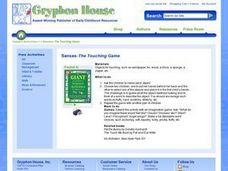Curated OER
When Land Ice Melts
Students investigate what happens when land ice melts. They discuss how the melting of land ice is different than the melting of icebergs. Students observe what happens as the ice melts.
Curated OER
Particulate Matter: How Dirty is the Air We Breathe?
Fourth graders work together to collect air samples for testing. They determine the amount of pollution in the air in their community. They discuss their results to end the lesson plan.
Curated OER
Building on the Power of Your Ideas
Pupils examine a sculpture walkway by artist Jackie Ferrara and discuss the relationship of materials to function. They analyze the sculpture and answer discussion questions, and design and construct a model of a walkway for the school.
Curated OER
Penny's Box
Students need to be able to calculate the volume and surface area of a cuboid as well as present a systematic list of results in order to justify the minimum case. The use of three factors of 100 is also important.
Curated OER
Architectural Acoustics
For this acoustics worksheet, students use a chart of the speed of sound through different materials to determine which materials should be used to build certain building types. Students complete 2 short answer questions.
Curated OER
Density Currents
Young scholars study how fluids of differing densities interact with one another, how densities of fluids can be changed, and how density currents transport and deposit tremendous amounts of sediment in lakes and in the ocean.
Curated OER
Senses -- The Touching Game
Students practice making educated guesses about objects in their hands. They guess what the object is without looking at it and choose a word that describes it. They practice using new vocabulary as well.
Curated OER
Heritage: Make a Model of a Typical Utah Settlement
Fourth graders examine the different types of settlements used in Utah. They take a community map of Utah past and present and compare the two. They create a model of the early types of settlements used by pioneers in Utah.
Curated OER
Solid Waste and Recycling
In this unit of lessons, students examine solid waste and recycling. They discover how litter is a major part of human waste. They also collect newspaper for recycling.
Curated OER
Using Maps To Make Public Health Decisions Case Study: Wildfires in Mexico 2000
Pupils study environmental health. Using actual NOAA satellite imagery, students investigate the basic concepts of mapping. They explore the relationship between monitoring satellite images and public health decision making.
Curated OER
The Science of Papermaking and Paper Recycling: A Research Experience for Teachers
Students explore the concept of paper recycling and the fiber that is yielded from the process. Students perform a coarse screening of recycled fiber and calculate the yield of the process.
Curated OER
Dream! (Part One)
Learners share with the class what they want to be when they grow up. As a class, they identify what they want to be for Halloween as well. They are videotaped stating their dream and photographed with their mask. Using the masks, they...
Curated OER
White-Tailed Deer
Students investigate the importance of white-tailed deer and their impact on forest environments. They visit learning centers to simulate being a white-tailed deer and work in groups. After visiting a forest they share their information...
Curated OER
Hardwood Lumber
Middle schoolers explore hardwood tree products and compare hardwood and softwood trees. They compare and contrast hardwood and softwood leaves and read a flier. After reading they solve equations related to how much feet of board would...
Curated OER
Open Wide
Students recognize the short vowel o in written and spoken language. Through matching and listening activities, they discriminate the vowel sound /o/ from other phonemes. Students associate the phoneme with its letter representation in...
Curated OER
Balanced Forces
Young scholars are able to explain why football running backs benefit from having a lower center of gravity when opponents are trying to tackle them. They explain why racing cars are designed to have a low center of gravity. Students...
Curated OER
DENSITIES OF REGULARLY SHAPED SOLIDS
Learners calculate the volumes of regularly shaped objects from measurements of their dimensions. They use several formulas and measure different objects to calculate the density, volume, and mass of the objects selected or assigned.
Curated OER
Wet 'n Wild Watershed
Students engage in a discussion on watershed management. In this ecology activity, students consider the role of forests in water quality. Students incorporate lecture material into a class room discussion and questions on water shed...
Curated OER
Inventions 2: The Impact
Learners research inventors and inventions and their impacts. In this invention lesson, students research inventions and their affects in good and bad ways.
Curated OER
Simple Machines make work easier.
Learners examine how simple machine work can make work easier. In this machines activity students complete an activity that shows them what makes up a machine, and how to measure displacement and velocity.
Curated OER
To Float or Not to Float - A Lesson on Density
Students define density in their own words. In this physics lesson, students calculate density using mass and volume. They explain why some objects sink and some float.






















